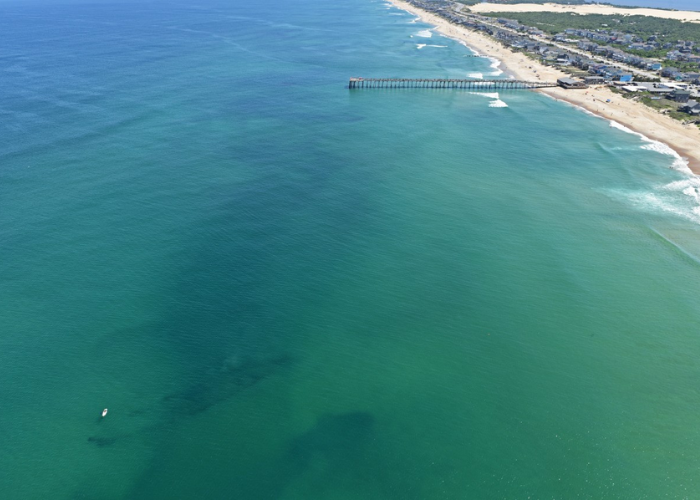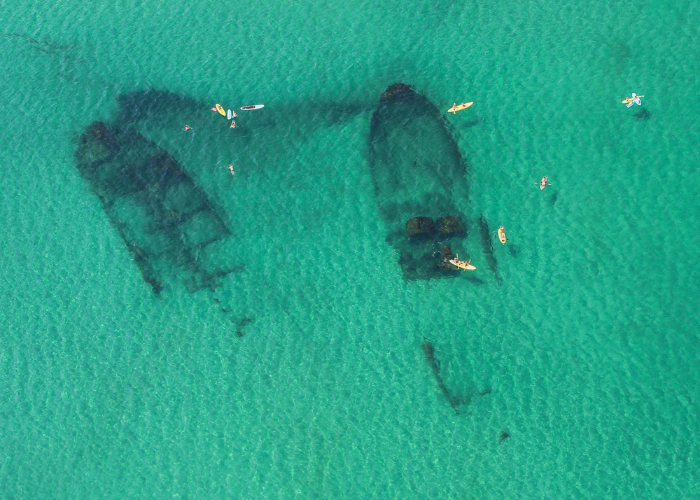There's a good reason why the Outer Banks is known as 'The Graveyard of the Atlantic. Despite the many lighthouses along the barrier islands built to guide ships, countless vessels have still met their demise on these shores. With the ever-changing tides, strong currents shifting the bottom of the ocean and unpredictable weather like fog and wind we think anyone can agree, the nickname is quite apropos.
Lighthouses, like those in Corolla and Nags Head, were built to mark safer passages, with each one emitting a unique light pattern to help captains navigate. Further south, the Cape Hatteras Lighthouse warns sailors of the shallow waters responsible for over 2,000 wrecks.
Also contributing to that number are navy battles and piracy contributing to the large number of shipwrecks from Corolla down to Ocracoke. If you are planning to visit our section of the Outer Banks, here are some shipwrecks that have yet to be completely erased by the ocean’s waves and gulf stream current and therefore still visible to explore.
The USS Huron
Headed for Havana from New York, on November 24, 1877, the USS Huron, a gunship steamer, ran aground in Nags Head. Located at Bladen Street Beach Access, MP 11.5 just north of the Nags Head Fishing Pier, this historic shipwreck lies 150 yards out and about 20-30 feet down and is typically marked by buoys. On a clear day like the one in the photo here, you can explore what is left of the iron-hulled warship by kayak, surfboard, or SUP.
While spending some time in Nags Head, you may hear a tale or two about how the town received its name. One theory, and probably our favorite is the tale of how pirates on land would attempt to lure ships close to shore by tying a lantern around the neck of an old nag and lead it along the beach at night. The lantern would mimic the appearance of a ships lantern bobbing up and down in the water tricking captains and their crew into thinking they were close to a safe place to drop anchor along other vessels. Once they inevitably ran aground, the sneaky pirates would loot the vessel for their cargo.

The Metropolis
Two months after the USS Huron Wreck, in January of 1878, another ship carrying workmen and supplies to build a railroad on the way to Brazil ran aground in Corolla just 100 yards from shore and halfway between two lifesaving stations. Eighty-five of the 245 passengers on board perished, thus prompting Congress to take action and authorize the construction of new life-saving stations. Today, most of the wreckage is buried; however, at times, during low tide or after major beach erosion, remnants of the steamship can be seen near the Currituck National Wildlife Refuge.
The Laura A. Barnes
Another notable shipwreck is the Laura A. Barnes. In 1920 a 120 foot four-masted schooner wrecked off the shores of Coquina beach in South Nags Head on its way to South Carolina from New York, ironically near the entrance of the Bodie Island Lighthouse. Dense fog during a nor’easter was to blame. The remains of this sailing vessel can still be found on the beach depending on the tide and shifting sands. The rudder now resides at the Graveyard of the Atlantic Museum in Hatteras, NC.
The Triangle Wrecks
Located near the Second Street beach access in Kill Devil Hills, MP 7. Two vessels, the Kyzickes and the Carl Gerhard had the misfortune of running aground in the same location about 2 years apart. The Carl Gerhard found themselves closer to shore than they thought and ran into the already sunken Kyzikos, making these wrecks resemble a triangle, hence the name.
Of course, we have some tales of how Kill Devil Hills was named too! Our favorite lore tells of barrels of rum washing ashore after a shipwreck. After a sip of the rum, it is said that it was so strong it could “kill the devil”. You will find a tall “hill” where the Wright Brothers Memorial now stands marking the location where the famous brothers took their first flight.

“The Winks Wreck”
Given its name from the popular Winks Market, this is located near Milepost 2 in Kitty Hawk off Luke Street. Sitting in about 20 feet of water and 120 yards off shore, this wreck is sometimes one of the more difficult to find. Timing is key. The water will need to be calm, and the tide high for a chance to spot this one. The ship has not been confirmed, but it is thought to be the British Steamer The Mountainer stranded in 1852.
The Oriental
The Oriental, a Civil War-era steamer, ran aground in 1861 off Pea Island near the Oregon Inlet. Known as the Boiler Wreck (or simply "Boilers" by surfers), it sits about 150 yards offshore in around 20 feet of water, depending on the tide. The wreck’s most prominent feature is its exposed boiler, which serves as a landmark for divers, surfers, and fishermen alike. The nearest beach access is across the street from the Pea Island Visitor’s Center.
There's a good reason why the Outer Banks is known as 'The Graveyard of the Atlantic.' Despite the many lighthouses built to guide ships along the barrier islands, countless vessels have still met their demise here. With ever-changing tides, strong currents, and unpredictable weather, it’s no wonder the nickname is so fitting.
Need equipment to get you to these sites? Ocean Atlantic Rentals has you covered!